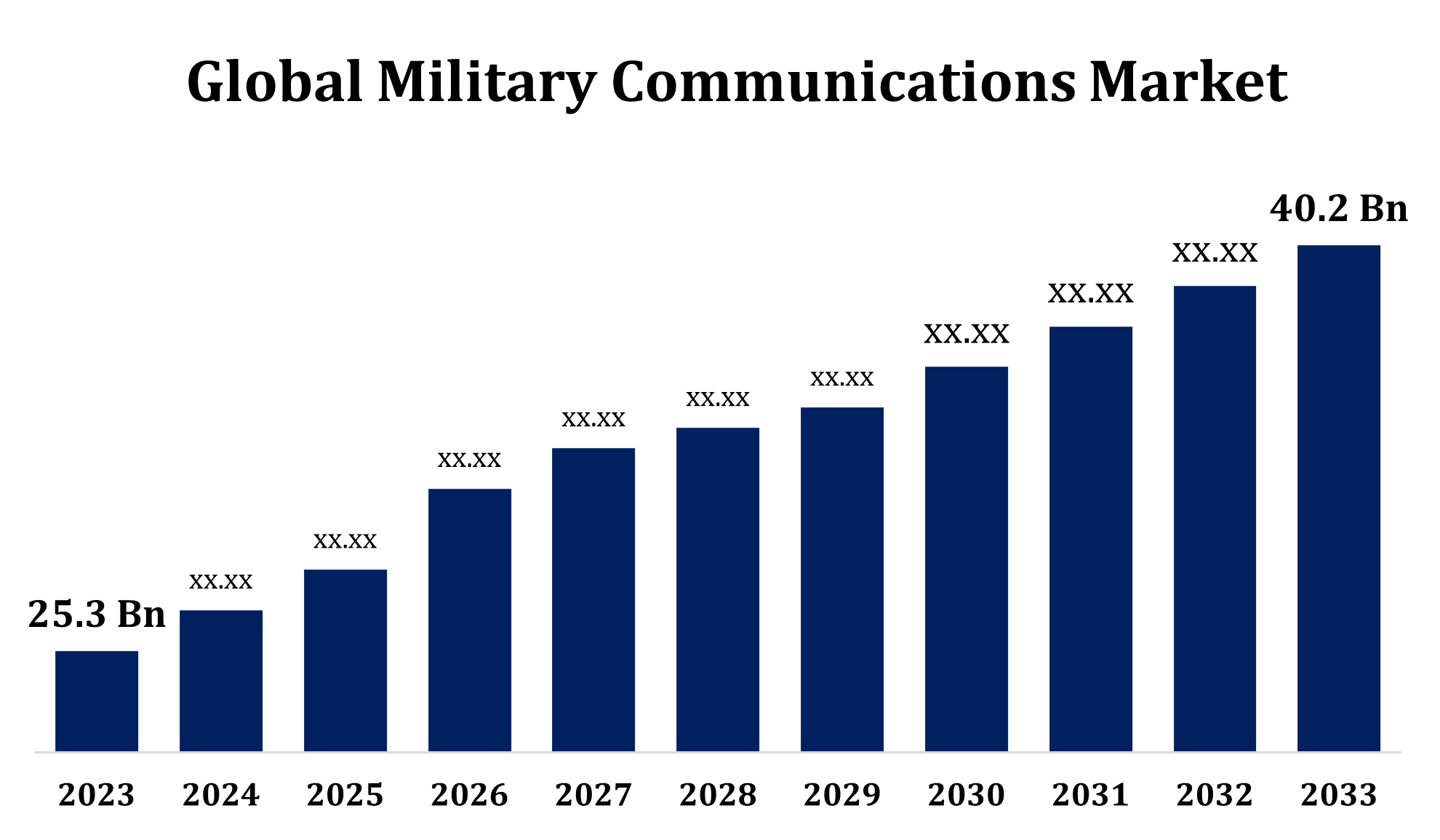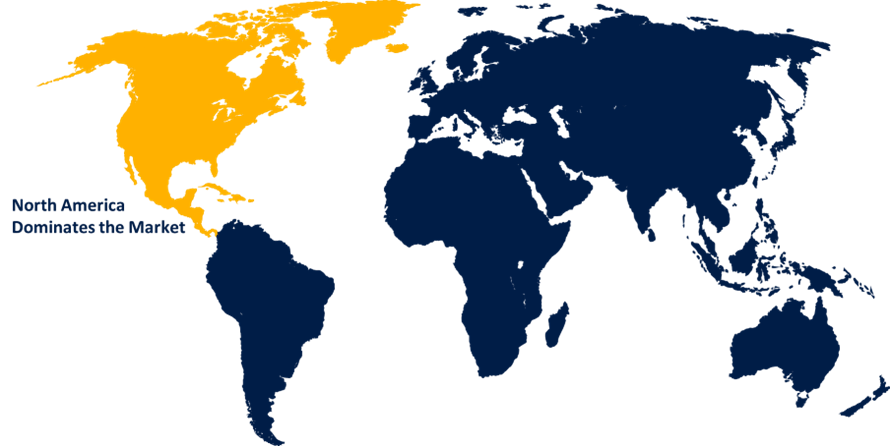Global Military Communications Market Size To Worth USD 40.2 Billion By 2033 | CAGR of 4.74%
Category: Aerospace & DefenseGlobal Military Communications Market Size To Worth USD 40.2 Billion By 2033
According to a research report published by Spherical Insights & Consulting, the Global Military Communications Market Size to grow from USD 25.3 billion in 2023 to USD 40.2 billion by 2033, at a Compound Annual Growth Rate (CAGR) of 4.74% during the forecast period.

Get more details on this report -
Browse key industry insights spread across 256 pages with 133 Market data tables and figures & charts from the report on the "Global Military Communications Market Size, Share, and COVID-19 Impact Analysis, by System (Satcom System, Radio System, Security System, Communication Management System), Platform (Land, Naval, Airborne, Unmanned Vehicles), Application (Military Satcom System, Military Security System, Communication Management System), and By Region (North America, Europe, Asia-Pacific, Latin America, Middle East, and Africa), Analysis and Forecast 2023 - 2033." Get Detailed Report Description Here: https://www.sphericalinsights.com/reports/military-communications-market
The military communications market plays a vital role in contemporary defense strategies, ensuring secure, reliable, and efficient information exchange across various platforms. It covers a broad array of technologies, such as satellite communication systems, encrypted radio networks, and data transmission solutions, all aimed at improving situational awareness and mission success. Key factors driving the market include advancements in wireless communication, an increased need for cybersecurity, and growing defense budgets worldwide. The integration of Artificial Intelligence (AI) and the Internet of Things (IoT) is revolutionizing military communications, providing real-time data analysis and autonomous decision-making capabilities. Despite challenges like interoperability issues and cyber threats, the market continues to innovate. It is set to grow, fueled by the increasing emphasis on network-centric warfare and the modernization of communication infrastructure.
Military Communications Market Value Chain Analysis
The military communications market value chain consists of several stages, starting with raw material suppliers who provide essential components like semiconductors, antennas, and transceivers. These components are then assembled into communication systems, such as radios, satellite terminals, and encrypted devices, by system integrators. Software developers create critical applications for secure data transmission, encryption, and network management. Collaboration between defense contractors, technology firms, and military organizations facilitates the deployment of these solutions. Distribution is primarily through government contracts and partnerships with defense agencies. Maintenance and upgrade services ensure continued operational effectiveness. The value chain is increasingly influenced by emerging technologies like AI, IoT, and 5G, fostering innovation and collaboration. The entire process is driven by defense needs, technological progress, and global geopolitical factors.
Military Communications Market Opportunity Analysis
The military communications market is poised for significant growth, fueled by evolving defense requirements and technological advancements. The growing emphasis on network-centric warfare, which prioritizes real-time information exchange, is driving demand for advanced communication systems. Emerging technologies such as 5G, AI, and IoT create opportunities for innovative solutions, including autonomous systems and improved situational awareness. The rising threat of cyberattacks underscores the need for secure, encrypted communication networks, boosting the growth of cybersecurity and anti-jamming technologies. Expanding defense budgets in developing regions like Asia-Pacific, the Middle East, and Africa offer new market opportunities. Furthermore, advancements in satellite communications, such as low-Earth orbit (LEO) satellites, deliver cost-effective global connectivity. Strategic collaborations between defense contractors, technology firms, and governments will be crucial in capitalizing on these opportunities and driving future growth.
The military communications market is witnessing substantial growth driven by the increasing integration of advanced technologies. Innovations such as Artificial Intelligence (AI), 5G networks, and the Internet of Things (IoT) are transforming communication systems, improving speed, security, and operational efficiency. AI facilitates real-time data analysis and autonomous decision-making, while IoT enables seamless connectivity among various military assets. The implementation of 5G improves bandwidth and reduces latency, enabling applications like augmented reality (AR) for enhanced battlefield awareness. Additionally, advancements in satellite communications, including low-Earth orbit (LEO) satellites, provide reliable global connectivity. These technologies address key challenges such as cybersecurity and system interoperability, making them essential to modern defense strategies. Rising defense budgets and a growing emphasis on network-centric warfare continue to drive this market's expansion.
The military communications market faces various challenges that hinder its growth and adoption. Interoperability between different communication systems is a major issue, especially as multinational defense collaborations increase. Another critical challenge is ensuring strong cybersecurity, as communication networks are prime targets for advanced cyberattacks. The complexity and high costs associated with deploying advanced technologies such as AI, 5G, and IoT can limit their widespread implementation, particularly in developing regions with budget constraints. Additionally, satellite communication systems are vulnerable to threats like anti-satellite weapons and space debris, which could compromise their reliability. Operational challenges, including maintaining communication in extreme environments and minimizing latency during critical missions, further complicate the situation. Overcoming these challenges will require innovation, international collaboration, and significant investments in research and development.
Insights by Platform
The unmanned vehicles segment accounted for the largest market share over the forecast period 2023 to 2033. The unmanned vehicles segment is witnessing substantial growth in the military communications market, fueled by the increasing use of unmanned aerial vehicles (UAVs), ground vehicles (UGVs), and maritime systems (UMVs) in defense operations. These vehicles rely on advanced communication networks for remote operation, real-time data transmission, and mission-critical tasks. The integration of technologies like Artificial Intelligence (AI), 5G, and satellite communications enhances their functionality, supporting autonomous decision-making and secure, high-speed communication. The growing shift towards network-centric warfare, along with the demand for improved surveillance, reconnaissance, and combat support, is driving the need for efficient communication systems in unmanned vehicles. While challenges such as cybersecurity threats and system interoperability remain, continued investments in research and development and advancements in communication technologies are expected to fuel the growth of this segment in the years ahead.
Insights by Application
The ISR segment accounted for the largest market share over the forecast period 2023 to 2033. The growth of the ISR segment is fueled by the increasing demand for real-time data collection, analysis, and distribution in defense operations. Advanced communication technologies, including 5G networks, Artificial Intelligence (AI), and satellite systems, are improving ISR capabilities by enabling quicker and more secure data transmission across platforms. Modern ISR systems provide vital insights for situational awareness, target identification, and mission planning, making them indispensable for network-centric warfare. Geopolitical tensions and cross-border conflicts are driving further investments in ISR technologies, especially in regions such as Asia-Pacific and the Middle East. Despite challenges like cybersecurity risks and integration complexities, continuous advancements in communication systems and rising defense budgets are expected to sustain growth in this segment.
Insights by System
The Military Satcom System segment accounted for the largest market share over the forecast period 2023 to 2033. Satcom systems are crucial for real-time communication, navigation, and intelligence sharing, allowing military forces to operate in remote or hostile environments. The increasing use of low-Earth orbit (LEO) satellites and advancements in satellite technology are enhancing military Satcom systems by providing greater bandwidth, lower latency, and improved operational flexibility. The shift toward network-centric warfare and the need for continuous communication during global missions are major drivers of this growth. Moreover, growing investments in defense modernization and satellite infrastructure are expected to further boost the military Satcom systems segment, despite challenges such as space debris and cybersecurity risks.
Insights by Region

Get more details on this report -
North America is anticipated to dominate the Military Communications Market from 2023 to 2033. The United States leads the region with its advanced defense initiatives, focusing on the adoption of cutting-edge technologies like Artificial Intelligence (AI), 5G, and satellite communications. These innovations enable real-time data sharing, improved situational awareness, and secure, high-speed networks for critical missions. Canada also plays a role in the market by investing in modern communication solutions for its defense forces. Key challenges in the region include maintaining robust cybersecurity and addressing interoperability issues across various systems. North America benefits from strong collaborations between government agencies, defense contractors, and technology providers, which drive innovation. The ongoing focus on network-centric warfare and the modernization of communication systems will ensure continued growth in the market.
Asia Pacific is witnessing the fastest market growth between 2023 to 2033. The region's emphasis on network-centric warfare, secure communication systems, and real-time data sharing is driving the adoption of technologies like Artificial Intelligence (AI), 5G, and satellite communications. Additionally, partnerships between governments and private technology firms are promoting innovation and the deployment of advanced systems. Despite challenges such as cybersecurity risks, interoperability issues, and the high cost of advanced infrastructure, the Asia-Pacific region is set to play a significant role in the global military communications market, driven by growing regional security concerns and expanding military modernization programs.
Recent Market Developments
- In August 2023, Ukraine has revealed that Rheinmetall will provide its new Luna NG (Next Generation) reconnaissance unmanned aircraft systems (UASs) as part of a USD 765 million military assistance package from the German government. This announcement was made during the NATO summit in Vilnius, Lithuania.
Major players in the market
- Raytheon Technologies Corporation (US)
- Northrop Grumman Corporation (US)
- Thales Group (France)
- Elbit Systems (Israel)
- L3Harris Technologies Inc. (US)
- Lockheed Martin Corporation (US)
- BAE Systems(UK)
- Saab AB (Sweden)
- Aselsan A.S (Turkey)
- Viasat Inc (US)
- Rheinmetall AG (Germany)
- Leonardo(Italy)
- Israel Aerospace Industries (Israel)
- Cobham Limited(UK)
- Honeywell International Inc (US)
Market Segmentation
This study forecasts revenue at global, regional, and country levels from 2023 to 2033.
Military Communications Market, System Analysis
- Satcom System
- Radio System
- Security System
- Communication Management System
Military Communications Market, Platform Analysis
- Land
- Naval
- Airborne
- Unmanned Vehicles
Military Communications Market, Application Analysis
- Military Satcom System
- Military Security System
- Communication Management System
Military Communications Market, Regional Analysis
- North America
- US
- Canada
- Mexico
- Europe
- Germany
- Uk
- France
- Italy
- Spain
- Russia
- Rest of Europe
- Asia Pacific
- China
- Japan
- India
- South Korea
- Australia
- Rest of Asia Pacific
- South America
- Brazil
- Argentina
- Rest of South America
- Middle East & Africa
- UAE
- Saudi Arabia
- Qatar
- South Africa
- Rest of the Middle East & Africa
About the Spherical Insights & Consulting
Spherical Insights & Consulting is a market research and consulting firm which provides actionable market research study, quantitative forecasting and trends analysis provides forward-looking insight especially designed for decision makers and aids ROI.
Which is catering to different industry such as financial sectors, industrial sectors, government organizations, universities, non-profits and corporations. The company's mission is to work with businesses to achieve business objectives and maintain strategic improvements.
CONTACT US:
For More Information on Your Target Market, Please Contact Us Below:
Phone: +1 303 800 4326 (the U.S.)
Phone: +91 90289 24100 (APAC)
Email: inquiry@sphericalinsights.com, sales@sphericalinsights.com
Contact Us: https://www.sphericalinsights.com/contact-us
Need help to buy this report?